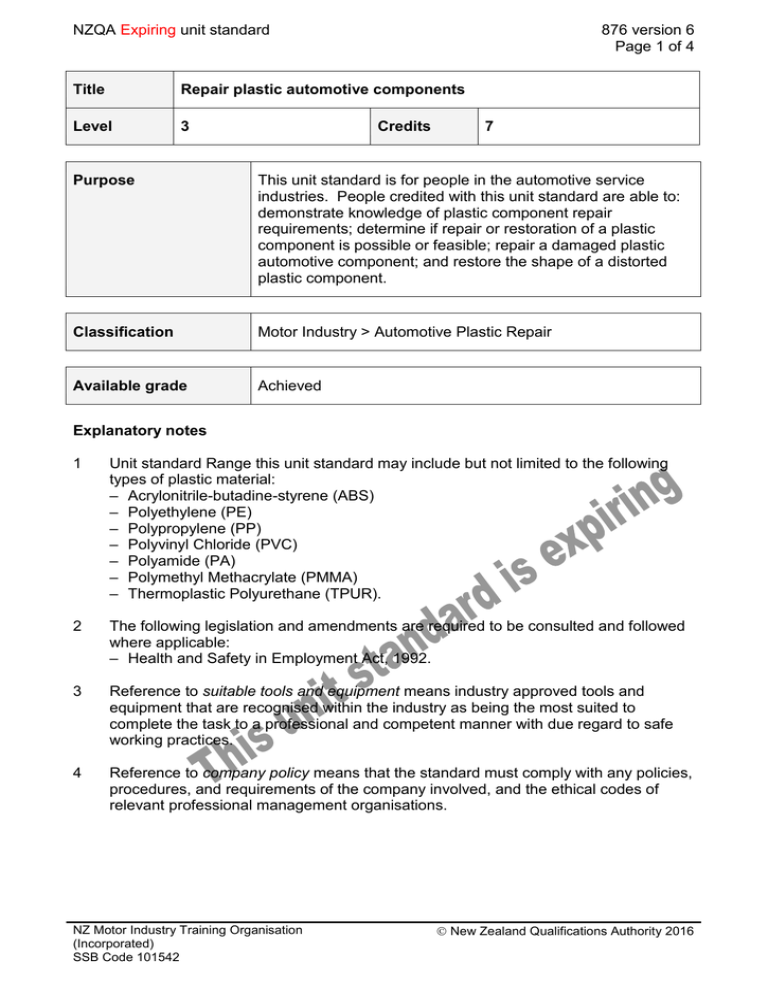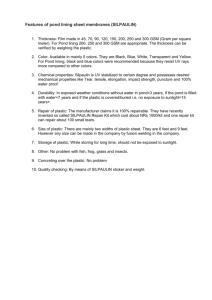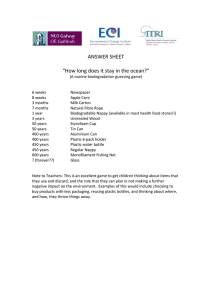NZQA unit standard 876 version 6
advertisement

NZQA Expiring unit standard 876 version 6 Page 1 of 4 Title Repair plastic automotive components Level 3 Credits 7 Purpose This unit standard is for people in the automotive service industries. People credited with this unit standard are able to: demonstrate knowledge of plastic component repair requirements; determine if repair or restoration of a plastic component is possible or feasible; repair a damaged plastic automotive component; and restore the shape of a distorted plastic component. Classification Motor Industry > Automotive Plastic Repair Available grade Achieved Explanatory notes 1 Unit standard Range this unit standard may include but not limited to the following types of plastic material: – Acrylonitrile-butadine-styrene (ABS) – Polyethylene (PE) – Polypropylene (PP) – Polyvinyl Chloride (PVC) – Polyamide (PA) – Polymethyl Methacrylate (PMMA) – Thermoplastic Polyurethane (TPUR). 2 The following legislation and amendments are required to be consulted and followed where applicable: – Health and Safety in Employment Act, 1992. 3 Reference to suitable tools and equipment means industry approved tools and equipment that are recognised within the industry as being the most suited to complete the task to a professional and competent manner with due regard to safe working practices. 4 Reference to company policy means that the standard must comply with any policies, procedures, and requirements of the company involved, and the ethical codes of relevant professional management organisations. NZ Motor Industry Training Organisation (Incorporated) SSB Code 101542 New Zealand Qualifications Authority 2016 NZQA Expiring unit standard 876 version 6 Page 2 of 4 Outcomes and evidence requirements Outcome 1 Demonstrate knowledge of plastic component repair requirements. Evidence requirements 1.1 The types of plastic material relevant to the automotive trade are identified with their uses on a motor vehicle. 1.2 The types of plastic repair are described according to manufacturer’s plastic repair instructions. Range 1.3 Repair equipment for a particular automotive application is identified. Range 1.4 hot air gun, filler rods, glue gun, sealants, heating oven, clamps, bonding agents, seals. The plastic welding process is described according to manufacturer’s plastic repair instructions. Range 1.5 welding, heating and reshaping, bonding, resealing. identifying the type of plastic to be welded, preparing the material to be welded, making the weld. Plastic adhesive systems are described according to manufacturer’s plastic repair instructions. Range single pack, two pack. Outcome 2 Determine if repair or restoration of a plastic component is possible or feasible. Evidence requirements 2.1 The feasibility of a repair is determined based on relevant factors. Range 2.2 type of material, type and extent of repair required, manufacturer's repair standards, cost of repair, availability and cost of a replacement. A recommendation, based on the feasibility of repairing the plastic component, is presented to the customer or supervisor. NZ Motor Industry Training Organisation (Incorporated) SSB Code 101542 New Zealand Qualifications Authority 2016 NZQA Expiring unit standard 876 version 6 Page 3 of 4 Outcome 3 Repair a damaged plastic automotive component. Range plastic welding, bonding, sealing. Evidence requirements 3.1 Safe working practices are observed throughout the task. Range personal safety, safety of others, welding equipment and vehicle safety. 3.2 Suitable tools, equipment, and materials are selected and used to enable the repair to be carried out. 3.3 The damaged part is prepared and repaired according to instructions for the material being repaired and the type of repair being effected, without departing from any of the component's original design characteristics. Range 3.4 vehicle manufacturer's instructions, repair material supplier's instructions. Arrangements are made for the repair to be painted according to company policy. Outcome 4 Restore the shape of a distorted plastic component. Evidence requirements 4.1 Safe working practices are observed throughout the task. Range personal safety, safety of others, welding equipment and vehicle safety. 4.2 Suitable tools and equipment are selected and used to enable the restoration work to be carried out. 4.3 The component shape is permanently restored by heating, clamping, and cooling. Replacement information NZ Motor Industry Training Organisation (Incorporated) SSB Code 101542 This unit standard has been replaced by unit standard 23741 and unit standard 23742. New Zealand Qualifications Authority 2016 NZQA Expiring unit standard 876 version 6 Page 4 of 4 This unit standard is expiring. Assessment against the standard must take place by the last date for assessment set out below. Status information and last date for assessment for superseded versions Process Version Date Last Date for Assessment Registration 1 29 October 1993 31 December 2016 Review 2 4 October 1996 31 December 2016 Review 3 26 February 1999 31 December 2016 Review 4 25 May 2007 31 December 2016 Rollover 5 19 November 2010 31 December 2016 Rollover 6 20 November 2015 31 December 2020 Consent and Moderation Requirements (CMR) reference 0014 This CMR can be accessed at http://www.nzqa.govt.nz/framework/search/index.do. Please note Providers must be granted consent to assess against standards (accredited) by NZQA, or an inter-institutional body with delegated authority for quality assurance, before they can report credits from assessment against unit standards or deliver courses of study leading to that assessment. Industry Training Organisations must be granted consent to assess against standards by NZQA before they can register credits from assessment against unit standards. Providers and Industry Training Organisations, which have been granted consent and which are assessing against unit standards must engage with the moderation system that applies to those standards. Consent requirements and an outline of the moderation system that applies to this standard are outlined in the Conesnt and Moderation Requirements (CMR). The CMR also includes useful information about special requirements for organisations wishing to develop education and training programmes, such as minimum qualifications for tutors and assessors, and special resource requirements. NZ Motor Industry Training Organisation (Incorporated) SSB Code 101542 New Zealand Qualifications Authority 2016


